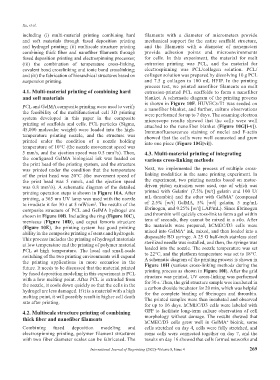Page 277 - IJB-8-4
P. 277
Xu, et al.
including (i) multi-material printing combining hard filaments with a diameter of micrometers provide
and soft materials through fused deposition printing mechanical support for the entire scaffold structure,
and hydrogel printing; (ii) multiscale structure printing and the filaments with a diameter of nanometers
combining thick fiber and nanofiber filaments through provide adhesion points and microenvironments
fused deposition printing and electrospinning processes; for cells. In this experiment, the material for melt
(iii) the combination of temperature cross-linking, extrusion printing was PCL, and the material for
covalent bond crosslinking and ionic bond crosslinking; electrospinning was PCL/collagen solution. PCL/
and (iv) the fabrication of hierarchical structures based on collagen solution was prepared by dissolving 10 g PCL
suspension printing. and 7.5 g collagen in 100 mL HFIP. In the printing
process test, we printed nanofiber filaments on melt
4.1. Multi-material printing of combining hard extrusion-printed PCL scaffolds to form a nanofiber
and soft materials blanket. A schematic diagram of the printing process
is shown in Figure 10F. HUVECs-T1 was seeded on
PCL and GelMA composite printing were used to verify a nanofiber blanket, and further, culture observations
the feasibility of the multifunctional cell 3D printing were performed for up to 7 days. The scanning electron
system developed in this paper in the composite microscope results showed that the cells were well
printing of scaffolds and cells. PCL particles (Sigma, attached to the nanofiber blanket (Figure 10G[i-v]).
45,000 molecular weight) were loaded into the high- Immunofluorescence staining of nuclei and F-actin
temperature printing nozzle, and the structure was showed that the cells were well connected and grew
printed under the condition of a nozzle holding into one piece (Figure 10G[vi]).
temperature of 10°C (the nozzle movement speed was
5 mm/s, and the ejection speed was 0.5 mm /s). Then, 4.3. Multi-material printing of integrating
3
the configured GelMA biological ink was loaded on various cross-linking methods
the print head of the printing system, and the structure
was printed under the condition that the temperature Next, we implemented the process of multiple cross-
of the print head was 20°C (the movement speed of linking modalities in the same printing experiment. In
the print head was 5 mm/s, and the ejection speed the experiment, two printing nozzles based on motor-
was 0.8 mm /s). A schematic diagram of the detailed driven piston extrusion were used, one of which was
3
+
printing operation steps is shown in Figure 10A. After printed with Gelatin (7.5% [w/t] gelatin and 100 U/
+
printing, a 365 nm UV lamp was used with the nozzle mL thrombin) and the other with GelMA (composed
to irradiate it for 30 s at 5 mW/cm . The results of the of 2.5% [w/t] GelMA, 5% [w/t] gelatin, 5 mg/mL
2
composite structure of PCL and GelMA hydrogel are fibrinogen, and 0.25% [w/t] LAP/mL). Since fibrinogen
shown in Figure 10B. Including the ring (Figure 10C), and thrombin will quickly cross-link to form a gel within
meniscus (Figure 10D), and caput femoris structure tens of seconds, they cannot be mixed in a silo. After
(Figure 10E), the printing system has good printing the materials were prepared, hCMEC/D3 cells were
+
ability in the composite printing of stents and hydrogels. mixed into GelMA ink, mixed, and then loaded into a
This process includes the printing of hydrogel materials disposable BD syringe. A 25 G half-inch stainless steel
at low temperature and the printing of polymer material sterilized needle was installed, and then, the syringe was
PCL at high temperature. The local and small-scale loaded into the nozzle. The nozzle temperature was set
switching of the two printing environments will expand to 22°C, and the platform temperature was set to 18°C.
the printing applications in more scenarios in the A schematic diagram of the printing process is shown in
future. It needs to be discussed that the material printed Figure 10H (various cross-linking methods during the
printing process as shown in Figure 10I). After the grid
by fused deposition modeling in this experiment is PCL structure was printed, UV cross-linking was performed
with a low melting point. After PCL is extruded from for 30 s. Then, the grid structure sample was incubated in
the nozzle, it cools down quickly so that the cells in the
hydrogel are less damaged. If it is a material with a high a carbon dioxide incubator for 20 min, which was helpful
for the complete binding of fibrinogen and thrombin.
melting point, it will possibly result in higher cell death The printed samples were then incubated and observed
rate after printing.
for up to 16 days. hCMEC/D3 cells were labeled with
4.2. Multiscale structure printing of combining GFP to facilitate long-term culture observation of cell
thick fiber and nanofiber filaments morphology without damage. The results showed that
hCMEC/D3 cells grew well in GelMA bioink, some
+
Combining fused deposition modeling and cells stretched on day 4, cells were fully stretched, and
electrospinning printing, polymer filament structures some cells were connected together on day 7, and the
with two fiber diameter scales can be fabricated. The results on day 16 showed that cells formed networks and
International Journal of Bioprinting (2022)–Volume 8, Issue 4 269

